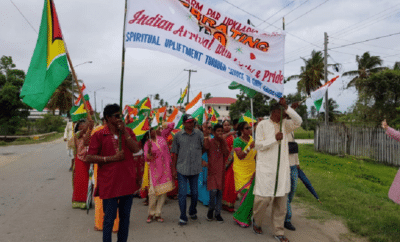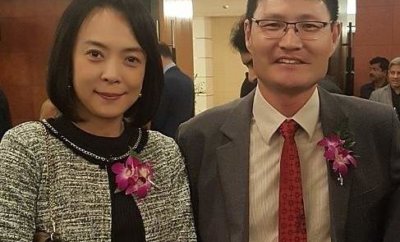Immigration
Surinamese Envoy Remembers Indian Ancestors at Suriname Ghat in Kolkata

Suriname ambassador Aashna Kanhai
About 145 years after the first ship set sail from Kolkata, Surinamese ambassador Aashna Kanhai gets nostalgic about her ancestors who left India.
Surinamese ambassador to India Aashna Kanhai got nostalgic about her ancestry during her recent visit to the “Mai Baap” Memorial at Suriname Ghat in Kolkata. Kanhai’s great-grandfathers were among the indentured laborers who left for Suriname.
Kanhai, who was accompanied by MJ Akbar, the Indian Minister of State for External Affairs, visited the spot on the occasion of her country’s Republic Day on Nov. 25, the Times of India reported. The memorial, situated at the banks of the Hooghly river, commemorates the landing of Indian laborers in Paramaribo. It is a replica of the memorial built at Paramaribo and was unveiled in Kolkata in 2015.
The event made Kanhai nostalgic about her Indian ancestors. “My ancestors must have stood here for the last time before leaving India forever. The men carried two dhotis and two kurtas each. The women carried two saris each. Apart from this, some carried religious books like the Ramayana, Mahabharata or Quran,” she said, according to the publication.
Nearly 34,300 Indian laborers were taken during different voyages to Suriname, at the northern tip of South America, by the Dutch colonists who owned sugar plantations there. The first ship set sail from Suriname Ghat with 410 passengers — men and women recruited as laborers from areas that are now Uttar Pradesh and Bihar. They set sail on February 26,1873 and docked at Paramaribo on June 5, with 279 men, 70 women and 50 children on board. In the following years, 63 more ships left from Suriname Ghat.
“Today, there are 170,000 people of Indian origin in Suriname (the total population is 558,368). There are also 200,000 of them in Holland who decided to leave Suriname when the country became independent 42 years ago,” Kanhai said.
In 1863, slavery was abolished by the Dutch. To fulfill the work requirements in sugarcane plantations, they entered into an agreement with East India Company to recruit laborers from India. According to Kanha, men — called Arkatias — were sent out to recruit people from Uttar Pradesh and Bihar. “They entered into a five-year contract and came to be known as the Contrakees or Agreemanees. They were to receive 25-pence a week for their labor but payment was often delayed. Of the 34,000-odd Indians who reached Suriname, 65 per cent stayed back. Indentured labor was finally abolished 100 years ago in 1917,” the ambassador added.
“The Hooghly wasn’t a river of hope. It was a river of no return. The peasants left their lands in the first place because of the huge taxation imposed by the colonial government in India. They had no surplus during lean seasons. Through such programs, we celebrate the resilience of human spirit,” Akbar was quoted as saying.
Dutch ambassador Alphonsus Stoelinga also talked of the shared histories with India and Suriname at the event.
Kolkata Port Trust is planning to organize heritage tours at the Suriname Ghat.




You must be logged in to post a comment Login